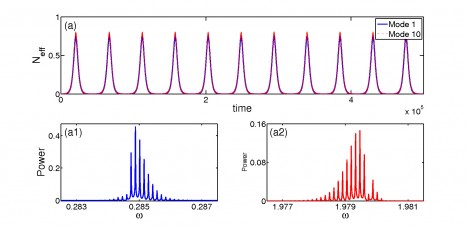A team of researchers at the Centre for Optical Quantum Technologies (ZOQ) of Universität Hamburg and at Nanjing University has discovered a way to create the analogue of an optical frequency comb for vibrations in solid matter including crystals. Optical frequency combs have become an important light source in modern physics, with diverging applications in various fields, such as metrology and ultracold quantum gases.
The mechanism which provides phononic frequency combs uses nonlinear resonances as a key ingredient. Frequency combs, especially in optical systems, normally refer to the generation of a series of equidistant spectral lines, via cascade excitations of the eigenmodes of the system, where each spectral line relates to the excitation of a single eigenmode. As a team of researchers including CUI-scientist Peter Schmelcher explains in the scientific journal Physical Review Letters a new frequency comb where only two or three eigenmodes are excited. In the generating process of the new type of discovered frequency combs, however, only two or three eigenmodes are excited. The frequency combs then manifest themselves as the splitting of the intrinsic frequency of each excited mode into a series of equidistant spectral lines. “Comparing to the traditional frequency combs, the new type can be viewed as a ’hyperfine’ comb structure around certain selected eigenmodes. Moreover these selected excited modes become correlated by the generation of the frequency combs”, Schmelcher explains.
This can be generalized to various nonlinear systems, from phononic to optical, as well as from classical to quantum systems. Such ’hyperfine’ combs can give rise to new applications in corresponding fields, such as high-accuracy frequency measurement and entanglement generations.
 llustration of a phononic frequency comb in a ten-site nonlinear atomic chain, where the first and tenth phonon modes are excited by a monochromatic external driving. Figure (a) shows the temporal fingerprint of frequency combs: A train of temporal pulses is shown for each of the two modes. Equidistant spectral lines are also observed in the spectrum of each modes in Figures (a1) and (a2), respectively, which serve as the spectral fingerprint of the frequency comb.
llustration of a phononic frequency comb in a ten-site nonlinear atomic chain, where the first and tenth phonon modes are excited by a monochromatic external driving. Figure (a) shows the temporal fingerprint of frequency combs: A train of temporal pulses is shown for each of the two modes. Equidistant spectral lines are also observed in the spectrum of each modes in Figures (a1) and (a2), respectively, which serve as the spectral fingerprint of the frequency comb.
Original:
L.S. Cao, D.X. Qi, R.W. Peng, M. Wang and P. Schmelcher
Phononic Frequency Combs via Nonlinear Resonances
Physical Review Letters 112, 075505 (2014)
DOI: 10.1103/PhysRevLett.112.075505

